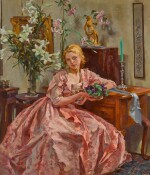(Women) Artists
(Women) Artists

Anna Airy
Young April
Lot Closed
March 23, 02:29 PM GMT
Estimate
15,000 - 20,000 GBP
Lot Details
Description
Anna Airy
1882 - 1964
Young April
signed A. Airy lower right
oil on canvas
Unframed: 89 by 76cm., 35 by 30in.
Framed: 107 by 94.5cm., 42 by 37¼in.
The artist; thence by descent (sale: Bonhams, London, 20 October 1994, lot 112)
Liverpool, Walker Art Gallery, Autumn Exhibition, 1935
Bradford and Huddersfield, 1936
Doncaster, 1937
Glasgow, Institute of Fine Arts and the Art Institute, Paisley, 1938
Bournemouth and Ipswich, 1939
Usher Art Gallery, Lincoln, 1944
R.B.A. Galleries, Suffolk Street, Anna Airy: Paintings, Drawings and Prints, 1952
Ipswich, Christchurch Mansion, Ipswich Art Club, Retrospective loan exhibition, oils, watercolours, pastels, etchings, drawings by Anna Airy RI ROI RE, 1985, no. 42
Miss Airy is one of our most versatile artists: a consummately equipped observer of nature in all phases, and a faultless and exhaustive draughtsman
(Art & Reason, May 1946)
Anna Airy was a talented and well-respected artist in oils, pastels, watercolours and etchings. In her lifetime she exhibited eighty works at the Royal Academy, showing almost every year. She included works in international exhibitions as far as New Zealand and Sweden and locally also exhibited at the Carfax Gallery, Paterson’s Gallery and the R.B.A Galleries in Suffolk Street.
Airy was born in 1882 in Greenwich to Wilfred Airy. She was an only child and her mother (Anna née Listing) died soon after she was born and she was therefore raised by her two aunts Christabel and Annot. She quickly revealed an interest and skill in painting and was accepted to the Slade school at the young age of 17. Here she studied with Augustus John, William Orpen under the kind tutelage of Fred Brown, Philip Wilson Steer and Henry Tonks. The Slade school was established by Felix Slade (lawyer and philanthropist) and notably granted women the same opportunities as men from as early as 1871; for instance, women were allowed to paint from live models rather than sculptures or casts. However, circumstances outside of school still made pursuing a career in art difficult, for example, women often had to stop work if they were married, they were excluded from certain groups and organisations that might further their career and different social responsibilities and expectations (to men) sometimes prevented them from submitting works for prizes and exhibitions.
Airy won scholarships and first prizes at school and was selected as one of the first female war artists employed by the Imperial War Museum in 1918 , a testament to her ambition and achievements. Despite her success, strict terms were imposed on her contract of employment (namely a right for the museum to refuse her work and to pay her). She painted four large works for the Sub-Committee, one titled A Shell Forge at a National Projectile Factory, Hackney Marshes, London, 1918 captured the raw heat of a munitions factory, specifically a shell casing forge. The factory workers (often women) underwent challenging working conditions, which in turn Airy experienced, remarking that at one point the heat of the ground nearly burnt through the soles of her shoes.
The present work is a wonderful celebration of spring and beauty. Airy has skillfully incorporated multiple still lifes within the same composition; pink and white lilies bloom in the background, a posy of violets are arranged in the sitter’s hands and a lone candle holder, with a bright turquoise candle, catches the viewer’s eye. She has painted the interior with sensitivity and care, in the background there are various wooden pieces of furniture, a painting in an elaborate gold frame, an embroidered wall hanging and a sculpture (perhaps depicting the independently-minded Goddess Diana with her bow). Young April is wearing a beautiful cascading dress, the subtle and varying pink tones are offset by the lilies behind her, and reflect off her skin in a soft glow. She faces the viewer, light catching the top of her golden hair.
